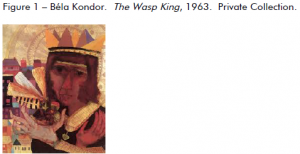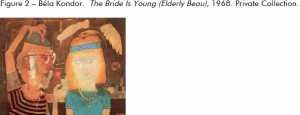Kev Nemelka and Dr. James Swensen, Art History & Curatorial Studies / Visual Arts Dept.
In preparation for my capstone/thesis project, I researched the life and works of Béla Kondor, a Hungarian Faux-Naïve Symbolist artist of the mid-twentieth century, and how his works are comparable to Utah Faux-Naïvists Andrew Ballstaedt, Fidalis Buehler, and Brian Kershisnik. Before I arrived in Budapest I arranged interviews and tours with the Contemporary Art Curator at the Hungarian Museum of Fine Art, the Chairman of the Board of Trustees for the Gábor Kogárt Art Foundation, the Contemporary Art Curator for the Miskolc Museum of Art, and one of the lead Hungarian scholars on Kondor’s oeuvre. I also hired a translator to help with difficult texts and interview transcriptions.
Because there is almost no research about Kondor translated into English, all aspects of his life and artworks needed to be explored. The research process turned out to be much more successful than I expected, and the scholars I interviewed provided me with helpful names, useful texts, and superb insights that made for a rather stress-free research process. Although my Hungarian skills have faded over the years, I was able to understand almost all of our interview conversations.
I approached the project with the hypothesis that Kondor would fit into the category of faux-naïve art—art created by academically-trained artists but made to resemble art by untrained/self-taught artists—as well as into the discussion of Utah Faux-Naïveté; the only things I knew about Kondor before my research were that he was academically trained and that, at least stylistically and thematically, much of his works could be connected to those of Ballstaedt, Buehler, and Kershisnik. I was pleased to find out that he was even more comparable to the Utah Faux-Naïvists than I had anticipated, especially compositionally and iconographically. Unfortunately, two of Kondor’s most famous works—The Wasp King (Fig. 1) and The Bride Is Young (Elderly Beau) (Fig. 2)— are part of a private collection that was difficult to access while I was in Hungary, so I wasn’t able to see and analyze those works in person. However, I was allowed to sort through the archives of the Hungarian Museum of Fine Art to find numerous scholarly articles about Kondor and his role in the development of Hungarian art as the country’s starting point of contemporary art.
Aside from the interviews I held in Hungary, I also conducted an intimate group interview with the three aforementioned Utah Faux-Naïvists regarding what it means to be fauxnaïvists, the controversy behind particular terminologies used when describing certain types of non-academic art, and the spiritual content of their works. The interview was published in the January edition of 15 Bytes: Utah’s Art Magazine, a reputable online publication managed by the Artists of Utah Organization, and received positive reception and reviews.
A preliminary draft of “Béla Kondor and the Transatlanticism of the Faux-Naïve Tradition” was also accepted for presentation at the 7th Annual Utah Conference of Undergraduate Research. I prepared a 20-minute visual presentation on the project and answered questions afterward regarding my research. Since it was not the final product of my research, I presented a condensed version of the most interesting parts of the larger body of work.
The final draft of my thesis will be finished by the end of this year for the senior thesis/capstone course. One of my professeurs has thoroughly edited and proofread the project, emphasizing some theoretical developments that need to be made within the paper, as well as some filtering and re-focusing. I will rework certain aspects of my research and present and defend my thesis in December. I also hope to submit it to be published and have been looking into appropriate academic journals.


